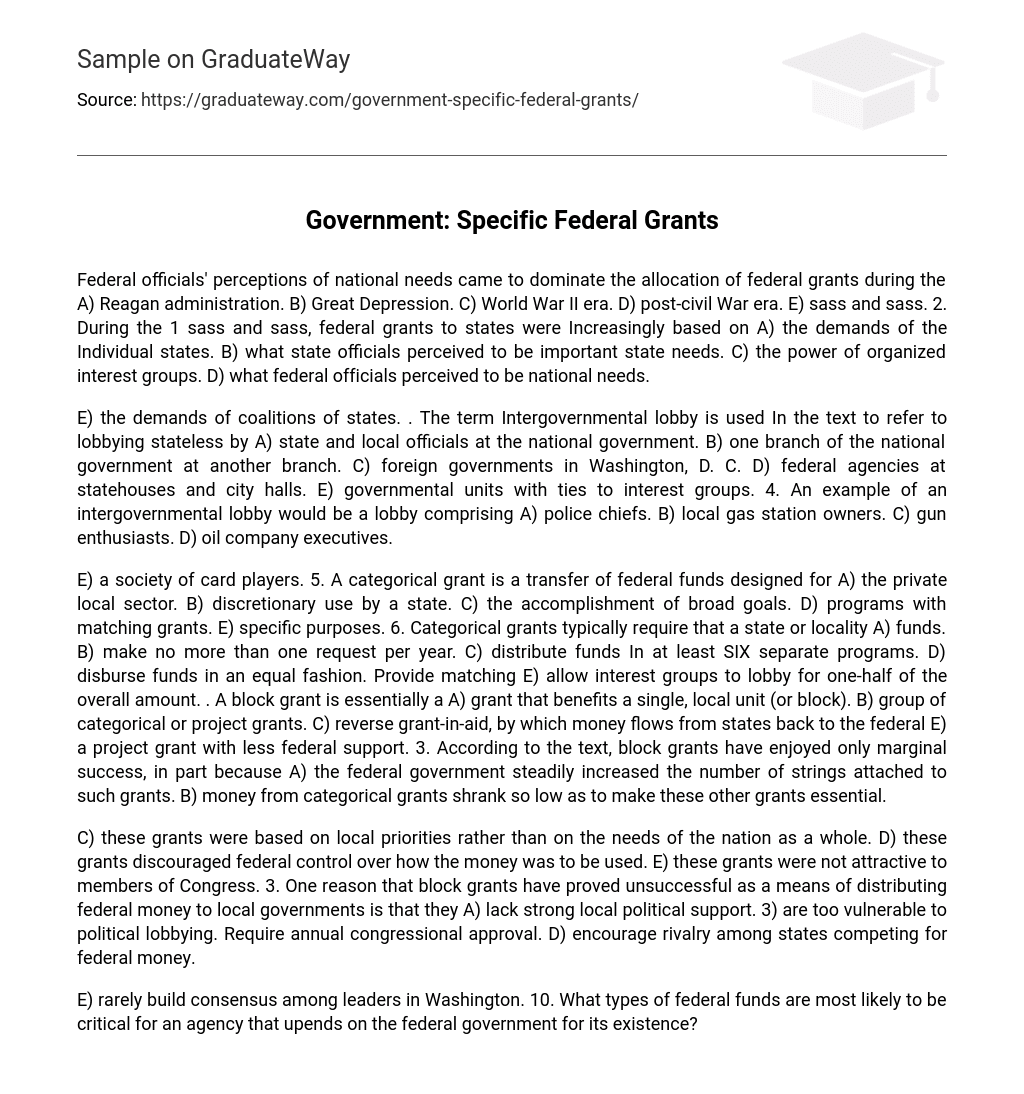Federal officials’ perceptions of national needs came to dominate the allocation of federal grants during the A) Reagan administration. B) Great Depression. C) World War II era. D) post-civil War era. E) sass and sass. 2. During the 1 sass and sass, federal grants to states were Increasingly based on A) the demands of the Individual states. B) what state officials perceived to be important state needs. C) the power of organized interest groups. D) what federal officials perceived to be national needs.
E) the demands of coalitions of states. . The term Intergovernmental lobby is used In the text to refer to lobbying stateless by A) state and local officials at the national government. B) one branch of the national government at another branch. C) foreign governments in Washington, D. C. D) federal agencies at statehouses and city halls. E) governmental units with ties to interest groups. 4. An example of an intergovernmental lobby would be a lobby comprising A) police chiefs. B) local gas station owners. C) gun enthusiasts. D) oil company executives.
E) a society of card players. 5. A categorical grant is a transfer of federal funds designed for A) the private local sector. B) discretionary use by a state. C) the accomplishment of broad goals. D) programs with matching grants. E) specific purposes. 6. Categorical grants typically require that a state or locality A) funds. B) make no more than one request per year. C) distribute funds In at least SIX separate programs. D) disburse funds in an equal fashion. Provide matching E) allow interest groups to lobby for one-half of the overall amount. . A block grant is essentially a A) grant that benefits a single, local unit (or block). B) group of categorical or project grants. C) reverse grant-in-aid, by which money flows from states back to the federal E) a project grant with less federal support. 3. According to the text, block grants have enjoyed only marginal success, in part because A) the federal government steadily increased the number of strings attached to such grants. B) money from categorical grants shrank so low as to make these other grants essential.
C) these grants were based on local priorities rather than on the needs of the nation as a whole. D) these grants discouraged federal control over how the money was to be used. E) these grants were not attractive to members of Congress. 3. One reason that block grants have proved unsuccessful as a means of distributing federal money to local governments is that they A) lack strong local political support. 3) are too vulnerable to political lobbying. Require annual congressional approval. D) encourage rivalry among states competing for federal money.
E) rarely build consensus among leaders in Washington. 10. What types of federal funds are most likely to be critical for an agency that upends on the federal government for its existence? A) Categorical grants 3) Block grants C) Fund grants D) Revenue-sharing programs E) Project enhancement grants 1 1 . Categorical grants are supervised by A) individual members of Congress from the relevant states. 3) the executive branch. Special committees of Congress. D) state governors. E) U. S. District courts. 12.
To qualify for certain federal highway funds, states must allow drivers to make legal right-hand turn after stopping ATA red light. This requirement by the federal government is known as a A) mandate. ) quid pro quo order. C) condition of aid. D) pro bono requirement. E) per curium order. 13. When a locality is required by federal law to do something, regardless of Neither it receives federal funding for that purpose, this duty is called a A) condition of aid. 3) mandate. C) string-attached edict. D) court decision. E) pontification. 14.
The difference between a mandate and a condition of aid is that A) with a mandate the federal government tells a state government what it must do if it wants categorical grant. C) a mandate applies to a categorical grant; a condition of aid applies to a block grant. D)with a mandate the federal government allows the state to do as it pleases if its actions are in accordance with federal law. E) with a mandate t makes no difference who is paying the costs off program. 15. Which of the following statements about mandates is not true? A) They are reasonable enough, stated in general terms. ) They are the result of court orders. C) They are tied to specific federal grants. D) They are open to interpretation by federal officials. E) They create administrative and financial problems. 16. Most federal mandates concern A) intrastate commerce. 3) the Internet. C) civil rights. D) the environment. E) C and D 17. Judges have ordered Massachusetts to change the way it hires firefighters, even though the state does not receive aid from the federal government for fire fighting. Such an order is referred to as a A) condition of aid. Mandate. 8. A 2006 study found that the highest number of unfunded mandates concerned E) education policy. 19. The text suggests that we might expect to find more mandates in policy areas Inhere the government A) spends less. 3) spends more. C) wants the states to spend less. D) has been involved a longer period of time. E) cannot possibly enforce them. 20. Federal courts have fueled the growth of mandates through litigation involving A) prison construction. 3) school desegregation. Police brutality. D) the hiring of firefighters. E) All of the above 21 .
Why do members of Congress who represent the interests of localities to the federal government pass laws that create so many problems for the mayors and governors of these localities? A) Because the structure of Congress is such that the parties to influence the votes of party members is so great C) Because mayors and overseen frequently resent federal interference in local affairs D) Because most members of Congress regard their role as that of representing the national government to localities.





